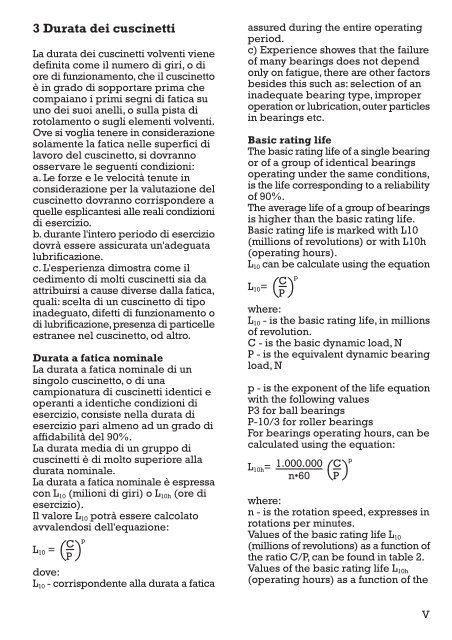CATALOGO TECNICO GENERALE 1.7.04 - Rodalsa
CATALOGO TECNICO GENERALE 1.7.04 - Rodalsa
CATALOGO TECNICO GENERALE 1.7.04 - Rodalsa
You also want an ePaper? Increase the reach of your titles
YUMPU automatically turns print PDFs into web optimized ePapers that Google loves.
3 Durata dei cuscinetti<br />
La durata dei cuscinetti volventi viene<br />
definita come il numero di giri, o di<br />
ore di funzionamento, che il cuscinetto<br />
è in grado di sopportare prima che<br />
compaiano i primi segni di fatica su<br />
uno dei suoi anelli, o sulla pista di<br />
rotolamento o sugli elementi volventi.<br />
Ove si voglia tenere in considerazione<br />
solamente la fatica nelle superfici di<br />
lavoro del cuscinetto, si dovranno<br />
osservare le seguenti condizioni:<br />
a. Le forze e le velocità tenute in<br />
considerazione per la valutazione del<br />
cuscinetto dovranno corrispondere a<br />
quelle esplicantesi alle reali condizioni<br />
di esercizio.<br />
b. durante l'intero periodo di esercizio<br />
dovrà essere assicurata un'adeguata<br />
lubrificazione.<br />
c. L'esperienza dimostra come il<br />
cedimento di molti cuscinetti sia da<br />
attribuirsi a cause diverse dalla fatica,<br />
quali: scelta di un cuscinetto di tipo<br />
inadeguato, difetti di funzionamento o<br />
di lubrificazione, presenza di particelle<br />
estranee nel cuscinetto, od altro.<br />
Durata a fatica nominale<br />
La durata a fatica nominale di un<br />
singolo cuscinetto, o di una<br />
campionatura di cuscinetti identici e<br />
operanti a identiche condizioni di<br />
esercizio, consiste nella durata di<br />
esercizio pari almeno ad un grado di<br />
affidabilità del 90%.<br />
La durata media di un gruppo di<br />
cuscinetti è di molto superiore alla<br />
durata nominale.<br />
La durata a fatica nominale è espressa<br />
con L10 (milioni di giri) o L10h (ore di<br />
esercizio).<br />
Il valore L10 potrà essere calcolato<br />
avvalendosi dell'equazione:<br />
C<br />
L10 = () P<br />
dove:<br />
L10 - corrispondente alla durata a fatica<br />
p<br />
assured during the entire operating<br />
period.<br />
c) Experience showes that the failure<br />
of many bearings does not depend<br />
only on fatigue, there are other factors<br />
besides this such as: selection of an<br />
inadequate bearing type, improper<br />
operation or lubrication, outer particles<br />
in bearings etc.<br />
Basic rating life<br />
The basic rating life of a single bearing<br />
or of a group of identical bearings<br />
operating under the same conditions,<br />
is the life corresponding to a reliability<br />
of 90%.<br />
The average life of a group of bearings<br />
is higher than the basic rating life.<br />
Basic rating life is marked with L10<br />
(millions of revolutions) or with L10h<br />
(operating hours).<br />
L10 can be calculate using the equation<br />
C<br />
L10= () P<br />
where:<br />
L10 - is the basic rating life, in millions<br />
of revolution.<br />
C - is the basic dynamic load, N<br />
P - is the equivalent dynamic bearing<br />
load, N<br />
p<br />
p - is the exponent of the life equation<br />
with the following values<br />
P3 for ball bearings<br />
P-10/3 for roller bearings<br />
For bearings operating hours, can be<br />
calculated using the equation:<br />
L10h=<br />
1.000.000<br />
n•60<br />
() p<br />
C<br />
P<br />
where:<br />
n - is the rotation speed, expresses in<br />
rotations per minutes.<br />
Values of the basic rating life L10<br />
(millions of revolutions) as a function of<br />
the ratio C/P, can be found in table 2.<br />
Values of the basic rating life L10h<br />
(operating hours) as a function of the<br />
V


